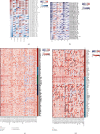The Potential Impact of HNRNPA2B1 on Human Cancers Prognosis and Immune Microenvironment
- PMID: 39268079
- PMCID: PMC11392580
- DOI: 10.1155/2024/5515307
The Potential Impact of HNRNPA2B1 on Human Cancers Prognosis and Immune Microenvironment
Abstract
HNRNPA2B1 is a member of the HNRNP family, which is associated with telomere function, mRNA translation, and splicing, and plays an important role in tumor development. To date, there have been no pan-cancer studies of HNRNPA2B1, particularly within the TME. Therefore, we conducted a pan-cancer analysis of HNRNPA2B1 using TCGA data. Based on datasets from TCGA, TARGET, Genotype-Tissue Expression, and Human Protein Atlas, we employed a range of bioinformatics approaches to explore the potential oncogenic role of HNRNPA2B1. This included analyzing the association of HNRNPA2B1 expression with prognosis, tumor mutation burden (TMB), microsatellite instability (MSI), immune response, and immune cell infiltration of individual tumors. We further validated the bioinformatic findings using immunohistochemistry techniques. HNRNPA2B1 was found to be differentially expressed across most tumor types in TCGA's pan-cancer database and was predictive of poorer clinical staging and survival status. HNRNPA2B1 expression was also closely linked to TMB, MSI, tumor stemness, and chemotherapy response. HNRNPA2B1 plays a significant role in the TME and is involved in the regulation of novel immunotherapies. Its expression is significantly associated with the infiltration of macrophages, dendritic cells, NK cells, and T cells. Furthermore, HNRNPA2B1 is closely associated with immune checkpoints, immune-stimulatory genes, immune-inhibitory genes, MHC genes, chemokines, and chemokine receptors. We performed a comprehensive evaluation of HNRNPA2B1, revealing its potential role as a prognostic indicator for patients and its immunomodulatory functions.
Copyright © 2024 Tao Huang et al.
Conflict of interest statement
The authors declare that there are no conflicts of interest regarding the publication of this paper.
Figures







References
MeSH terms
Substances
LinkOut - more resources
Full Text Sources
Medical
Molecular Biology Databases
Research Materials
Miscellaneous

